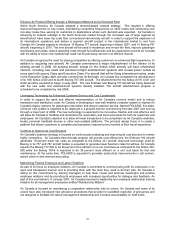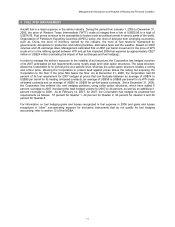Air Canada 2006 Annual Report Download - page 20
Download and view the complete annual report
Please find page 20 of the 2006 Air Canada annual report below. You can navigate through the pages in the report by either clicking on the pages listed below, or by using the keyword search tool below to find specific information within the annual report.due to higher cash balances and higher average interest rates. Capitalized interest includes interest on funds
used to finance the acquisition of new flight equipment and other property and equipment for periods preceding
the dates that the assets are available for service. Refer to Note 2 to Air Canada’s combined consolidated
financial statements for additional information on interest capitalized. In Quarter 4 2006, the Air Canada
Services segment recorded an impairment provision of $7 million relating to one property. In Quarter 4 2005,
loss on sale and provisions on assets amounted to $30 million of which approximately $15 million related to the
write-down of inactive Boeing 747 inventory.
Losses from the revaluation of foreign currency monetary items amounted to $107 million in Quarter 4 2006,
attributable to a weaker Canadian dollar at December 31, 2006 compared to September 30, 2006. This
compared to losses of $11 million in Quarter 4 2005.
A segment loss of $144 million was recorded in Quarter 4, 2006 compared to a segment loss of $135 million in
Quarter 4 2005.
7.2 Summary of Jazz Segment Results
Jazz recorded operating income of $33 million in Quarter 4 2006, pursuant to the Jazz CPA, compared to
operating income of $34 million in Quarter 4 2005, pursuant to the Initial Jazz CPA. EBITDAR for Quarter 4
2006 improved $6 million over the corresponding period in 2005. The increase in EBITDAR was mainly due to
a growth in fleet size consistent with Jazz’s plan to increase its relative share of the North American ASM
capacity, an increase in hours of contract flying under the Jazz CPA, as well as cost control.
The Jazz CPA came into effect on January 1, 2006. The major changes from the Initial Jazz CPA include: a
longer term, a larger number of Covered Aircraft with a guaranteed minimum of 133 aircraft throughout the term,
and Jazz expenses now reimbursed by Air Canada at a higher mark-up for controllable costs, and on an at-cost
basis by Air Canada for other expenses.
Operating revenues for Quarter 4 2006 increased $48 million or 16 percent compared to the corresponding
period in 2005. The significant increase in revenues was due to a net addition of 14 aircraft operated by Jazz
resulting in a 21 percent increase in block hours flown over Quarter 4 2005 as well as higher pass-though costs
charged to Air Canada under the Jazz CPA.
Operating expenses increased $49 million or 18 percent compared to Quarter 4 2005 and included an increase
in pass-through costs of $18 million or 17 percent in Quarter 4 2006, driven largely by a capacity increase of 26
percent over the corresponding period in 2005. Unit cost for Quarter 4 2006 decreased 8 percent over the
same period in 2005, in part due to an increase in longer-haul flying which generally results in lower unit costs
per ASM. Excluding fuel expense, unit cost for Quarter 4 2006 was down 5 percent over the corresponding
period in 2005. The unit aircraft rental cost increase mainly reflected six CRJ-200 aircraft deliveries and the
transfer of 10 CRJ-100 aircraft from Air Canada partly offset by a termination of two Dash 8 aircraft operating
leases.
Segment income of $32 million was recorded in Quarter 4, 2006, unchanged from Quarter 4 2005.
7.3 Summary of Consolidated Results
The Corporation, as defined under “Basis of Presentation”, recorded operating income of $29 million for Quarter
4 2006, an improvement of $86 million from the operating loss of $57 million recorded in the same period in
2005.
Losses from the revaluation of foreign currency monetary items amounted to $107 million in Quarter 4 2006
attributable to a weaker Canadian dollar at December 31, 2006 compared to September 30, 2006. This
compared to losses of $11 million in Quarter 4 2005.
Net loss for Quarter 4 2006 amounted to $144 million or $1.55 per diluted share compared to a net loss of $135
million or $1.53 per diluted share for Quarter 4 2005.
Unit cost, as measured by operating expense per ASM, decreased 2 percent over Quarter 4 2005.
20
























